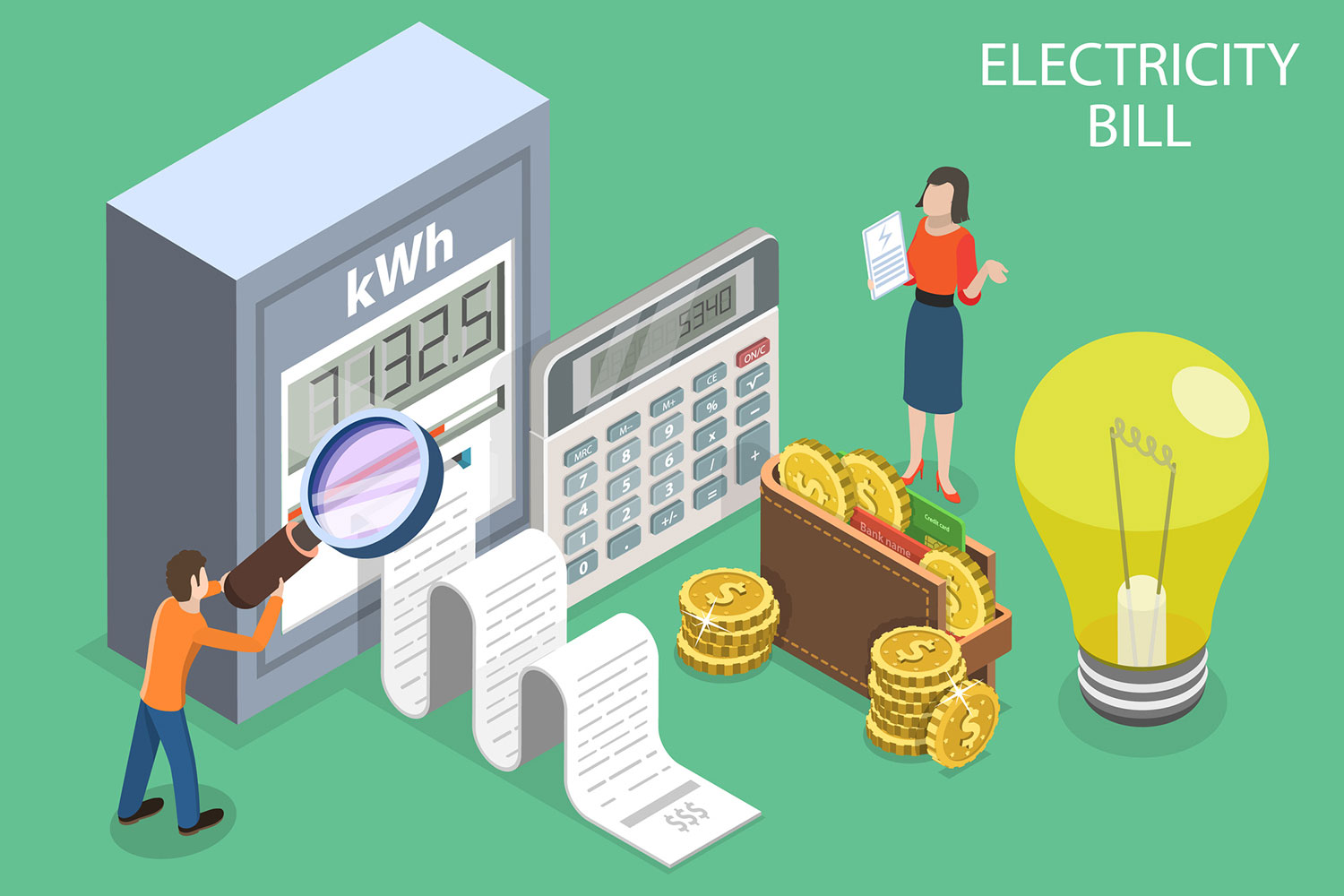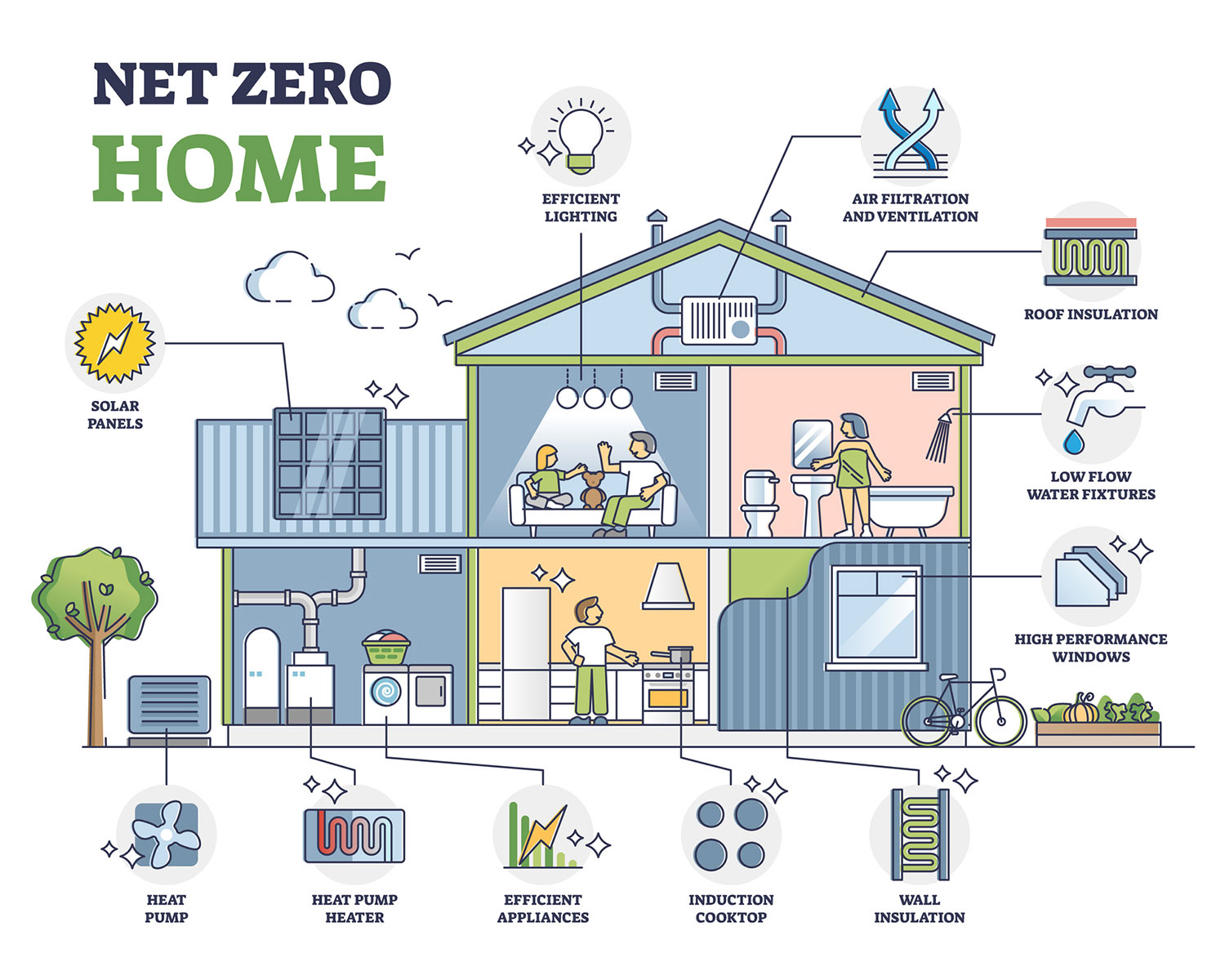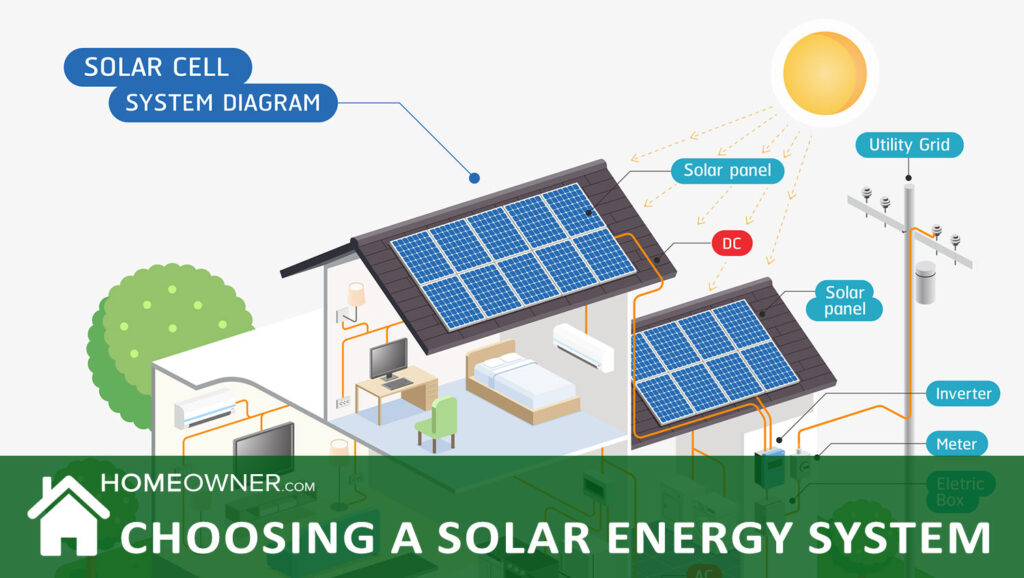You can measure the exact size solar energy system you need to meet all your home’s energy needs.
Determining your home’s exact energy needs (otherwise known as doing an energy audit or doing an electrical audit) isn’t as hard as you may think. That’s because it involves simply checking out your current utility bill, understanding how solar works, and then doing a few easy calculations.
Get A FREE Home Solar Quote Now
How To Do an Energy Audit Using Kilowatts
The power company measures your energy usage using kilowatts. The more electricity your home consumes, the higher the kilowatts reading that will be appearing on your electric bill.
By using this reading, you can determine exactly how much power yo use and thus how much you’ll need to make.
Follow these instructions to determine the size of solar energy system you need to meet all of your home’s energy requirements (doing a home energy audit).
Determining Your Energy Needs (Electricity Audit)
First, look at your electric bill and get the kilowatt reading. The kilowatt reading should be right beside the “kWh” abbreviation on your bill. Make sure the reading is for a month with average use.
If an average use month is too hard to select, then add up every month’s kWh usage for the entire year and divide by 12 to get the average kilowatts used per month.
Next, divide your monthly average kilowatt use by 30 to get your daily average use. Then, divide this number by the average number of full sun hours that there are per day in your area (usually 5-7 hours).
Multiply this new number by 1.15 just to be sure you make up for any unforeseen inconsistencies in effectiveness. This will give you your total in Kilowatts. To convert this to watts, just multiply by 100. This will give you a better understanding of what size solar system is needed.
Home Energy Audit Example

Let’s say the average monthly kilowatt reading on your electric bill was 300 kwh. Divide 300 by 30 (days) = 10 kilowatt hours per day. If you have an average of 6 hours of full sunlight per day, you would then divide 10 by 6 (hrs of sun per day) = 1.67. Then multiply by 1.5 = 2.5. And finally, multiply by 1000 to convert to watts.
2.5 x 1000 = 2500 watts of power is needed per hour to meet all of your energy requirements.
Your solar system will need to produce 2500 watts per hour.
Even if you don’t plan to create this much energy, you should still use this method (doing an energy audit) to determine how much power (watts) you would need, so that you have a clear idea of what to eventually strive for.
Determining The Roof Space Needed
By using the calculation in the energy audit example above, we can then determine the approximate amount of roof space (in square feet) that we’ll need to accommodate the solar panels we require.
To do this, you must first find out how many kilowatts per hour your solar system can produce for every 100 square feet of panel, then multiply this number by 100.
To give you some idea of this number. A solar system with high efficiency cells is typically capable of producing 1 kw per hour for every 100 square feet. This is something you may want to remember when doing a home energy audit.
Therefore, since we determined that you need to produce 2.5 kw for every hour of full sun (in our energy audit example above), you will need 2.5 x 100 = 250 square feet of dedicated space and therefore 250 square feet of solar panels.
Solar Power System Sizing
There are two primary methods for determining the size and specifics of the solar energy system they will need.
Method 1: “Make Some Now, Add Some Later”
Some people handle solar PV system sizing by choosing a standard sized solar system first, implementing it onto their house, and then using whatever solar power they get out of it in conjunction with electricity from the power company.
These people can also add more solar panels to their system in the future and increase their solar power production gradually as their funds allow. They generally build less power than they will need and sort of “learn along the way” (through actually using it) how much more power they will be requiring. This solar PV system sizing method is kind of like “playing it by ear.”
Over time, they can build their systems up to provide all the power they need and even eventually use no power from their utility company at all.
This is a very common approach (to solar system sizing) as it allows homeowners to get their foot in the “solar door” and start benefiting from solar power, quickly, for the least expense and without too much tedious planning.
Method 2: “Make Enough For All Your Needs Now”
Another way that people determine the size of the solar system they will need (solar PV system sizing) is by figuring out exactly how much power their home consumes and then building a PV system that can handle that load.
Please note that even if you do decide to start small and add panels over time, you should still figure out what size system your household will require for all your energy needs. This way, you will have a good idea of what size system to eventually strive for.
Determining this calculation requires you to do some investigation in and around your own home. More specifically, you will need to check the kilowatt usage on your electric bill and measure the available sunlight in your area.
From these calculations, you can determine how many watts the solar system you build will need to have to accommodate all of your home’s energy needs. By determining the watts your system needs to produce to accommodate all your home’s energy needs (doing an energy audit).
Understanding How Many Watts, Volts, and Amps You Will Need for Your Appliances
Regardless of whether you decide to start with a PV system big enough to accommodate all or just some of your energy needs, you are still going to need to understand how many watts, volts, and amps you’ll be producing and whether it will be enough for all (or some) of your specific appliances and power storage capacity needs.
This is an important part of the solar system sizing process, especially if you are going to be adding solar power as you go (over time).
You will need to ask yourself some basic questions related to solar PV system sizing like:
- How many watts will I need for my specific power use?
- How many volts should my system produce for my specific appliances?
- How many amps do I need in order to be able to produce solar energy fast enough for my usage needs?
How many watts will I need for my specific power use?
A Watt represents the amount of power produced or used. Think of it sort of like your “power reserve”.
When it comes to PV system sizing, you need to make sure you have enough watts to power all of your specific appliances.
Sometimes the watts required for certain appliances are more than you may have directly available or stored. Eg. Trying to power a refrigerator with a PV system that produces very little power (watts) per hour or with a battery bank that has very little power (watts) stored.
Increasing or decreasing the watts your system can produce and store is accomplished by adding more solar panels and batteries to your PV system. Add more panels to make more power. Add more batteries to store more power.
Let’s say you want to power a laptop computer with your solar system.
You need to check your laptop’s watt rating (check the sticker on the back of the computer and multiply the volts x amps to get the watts).
If your laptop is rated at 72 watts, then this means it needs 72 watts of power per hour to run. So your solar system must also be able to either produce or provide from the battery bank up to 72 watts or more per hour in order to have enough juice to power the laptop computer.
Determining your daily, weekly or monthly watt usage
So how do you determine your watt usage for the whole month, week, or day?
The answer is: You have to calculate the watt hours.
Watt hours / Kilowatt hours
Watt / Kilowatt hours is the measurement used by your electric company to charge you on your bill. It represents the number of watts consumed multiplied by the number of hours you consume it for. One watt hour is equal to consuming one watt of power per one hour.
Watt hours = # of watts consumed x # of hours
A kilowatt is equal to 1000 watts. It’s just another way of saying 1000 watts, only it appears neater and is less bulky looking on your utility bill. So one kilowatt hour is equal to consuming 1000 watts of power for one hour.
To calculate the amount of watts/kilowatts a specific appliance consumes (and therefore will need your solar system to produce) you need to find out two pieces of information.
- The watt rating of the appliances you will be using.
- And how long you use each appliance.
Watts

So, if for the time period of 1 day, you used your 72 watt laptop for 4 hours, you would have used 72w x 4hrs = 288 watt hours (that’s not even a kilowatt) therefore the amount of watts that would have to be readily available from your solar system battery bank would be 288 watts for the whole day.
To calculate the total amount of watts you consume for all your appliances (or a specific group of appliances), you would have to go around to all of those appliances, get the watt rating off each, and multiply each by the number of hours you would normally use that appliance for.
Then, add up all the totals and you will know approximately how many watts/kilowatts of power you need your solar system to be able to produce to accommodate those appliances for the time period that you specify (month/week/day).
As you can see, your daily solar power potential greatly depends on how many watts you are able to capture and store during daylight hours.
If your solar system is rated at 300 watts total, this means that the most your system can produce / store is 300 watts of power for each hour your solar panels are in optimal sunlight conditions, but this number may be much less in non-optimal sunlight conditions.
Depending on the size of your system and how many hours of sunlight you have available during the day, you can produce and store energy in your battery bank all day long and use it as you need it.
With our 300 watt system example above, if you had 6 hours of optimal sunlight per day, you could potentially store 300w x 6 = 1800 watts per day. That’s way more than enough juice to power your laptop which only requires 288 watts for 4 hours use (or 72 watts per hour).
Always check your own electronics or appliances for the right watt rating but just to give you an idea of what to expect, here are some common wattages for some common appliances:
- Clock radio: 10 watts
- DVD player: 40 watts
- Small TV: 54 watts
- Light bulb: 60 watts
- Laptop computer: 72 watts
- Ceiling fan: 120 watts
- LCD tv: 200 watts
- Hand-held blender: 350 watts
- Refrigerator: 500 watts
- Coffeemaker: 800 watts
- Toaster: 1000 watts
- Microwave oven: 1000 watts
- Hot plate: 1100 watts
- Power saw: 1350 watts
- Vacuum cleaner: 1600 watts
Although some appliances like the hot plate may seem to have a higher than normal watt rating compared to a TV, these appliances are typically used for smaller periods of time so the overall wattage used balances out and isn’t as big as you may think.
The more watts your solar system has, the more power you can produce and store in your battery bank for use whenever you want.
How many volts should my system produce for my specific appliances?
Volts represent the pressure of electrical flow (the push).
When it comes to PV system sizing, you need to make sure you have enough volts in your system to power your specific appliances (which also have a volt rating on them).
If you are operating an appliance with a high voltage rating, you will need your system/battery bank to have that same voltage (actually a little higher) to supply enough power to it for it to work.
Increasing or decreasing the voltage is accomplished through the arrangement/wiring of your solar panels and your battery bank.
Let’s say you want to power your laptop computer with your solar power system. The first you should do is check its volt rating. This should be on a sticker located on the underside of the computer itself.
If your computer is rated at 24 volts, then your solar system must also be able to produce up to 24 volts or more in order to power that device. It’s okay to power a device rated at lower voltage with a system that produces higher voltage, but if you tried it the other way around you wouldn’t have sufficient “push” to power the higher voltage appliances.
The different voltage ratings are as follows:
- 12 volts
- 24 volts
- 48 volts
- 120 volts
- 240 volts
If your solar energy system is rated at 36 volts, you will be able to power appliances up to 24 volts, but not 48 volts, 120 volts, or 240 volts. If your solar system is rated at 54 volts, you’ll be able to power appliances up to 48 volts, but not 120 volts and 240 volts. If your solar system is rated at 126 volts, you’ll be able to power appliances up to 120 volts, but not 240 volts. If your solar system is rated at 252 volts, you’ll be able to power appliances up to 240 volts.
Always check your own electronics or appliances for the right volt rating but just to give you an idea of what to expect, here are some common voltage ratings for some common appliances:
- Plug-in burner element (Hot plate): 12 volts
- Clock radio: 12 volts
- Lamp: 12 or 24 volts
- Laptop computer: 24 volts
- AC contractor unit: 24 volts
- LCD TV: 120 volts
- Tabletop oven: 120 volts
- Water heater: 240 volts
- Dryer: 240 volts
- Oven: 240 volts
The more volts your solar energy system has, the more varieties of higher voltage appliances you can power with it – provided you have the watts to supply the power.
One way of getting around this is to use (or buy) appliances with low voltage ratings. Imagine how much money you would save if you bought some of your home’s appliances at the RV and camper store. You may be surprised at what’s available in very low voltage ratings.
How many amps do I need in order to be able to produce solar energy fast enough for my usage needs?

Amps represent the intensity (and amount) of current and thus determine the size of the wire needed.
When it comes to PV system sizing, you need to make sure you have enough amps to make / store power as fast as (or faster than) you use it. And you also need to ensure you have the right size wire to handle the current.
So, if the solar system you build has a total of 7 amps, then you would need to buy 7 amp wire. Actually, to be on the safe side, you should buy 8 or 9 amp wire, just so you know it can handle the current.
The more amps your system has, the faster you can make/store energy and the more energy you will have available to use – that is, if you have enough batteries to store it. When you increase the amps of your solar system, it’s like you are literally using a bigger wire that allows more power through at once.
If you have enough amps as well as enough batteries, you can increase your production and storage capacity so you never run out of solar power. Increasing or decreasing the amps is accomplished through the arrangement /wiring of your solar panels. You will also need more batteries to store the extra power.
Amps
So let’s say you needed your solar system to produce power super fast because you had high energy needs and you wanted to take advantage of your huge battery bank’s large capacity by charging it back up faster after use.
To do this, you would need to arrange the panels in your solar system to increase the total amps. Let’s learn about “amp hours” and how they affect our solar system.
Amp Hours
Amp hours represent how much electrical current can flow per hour, so if your battery says 105 amp hours on it, then this means you could charge it to produce 105 total amps during the course of an hour.
This is meant to give you an indication of the storage capacity of the battery and how long it takes a battery to discharge.
The more amp hours you have in your battery bank the longer your total power reserve would take to deplete.
Now that you know how solar system sizing works, you will have a better idea of what size solar energy system you will need for your specific appliances and household loads. By auditing your home carefully and accurately, you can get the most out of your solar energy system.





